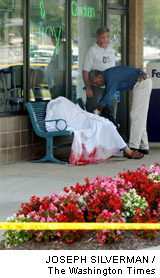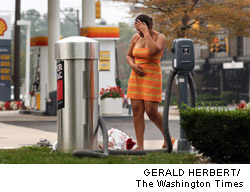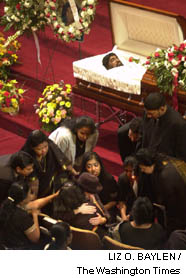| A Nation
on Edge
November 2002
by Cliff Owen |

|
"Do you
know about the shooting?" she asked as we walked across the newspapers
parking lot. "Yes, guy at the grocery store last night - sounds
like a routine murder" I replied. "No, the one this morning!"
Within an hour we had five dead and four photographers on the scene.
So began our three-week long nightmare of sniper
shootings.
I'm a third generation Washington native and
have worked as a photographer in the area since 1979 -- at Northern
Virginia newspapers, UPI Washington and currently The Washington Times.
I came to the paper in 1994 as a photographer
and became the Assignment Editor two years ago. My knowledge of the
area and coverage of spot news was useful during the sniper story. It
helped us navigate photographers to the scene of shootings, the police
roadblocks, and it helped me know who was
closest to the story, including the Fredericksburg shootings, 60 miles
south of DC.
I was able to call upon contacts at other news organizations
for information. But nothing in my experience of covering news could
tell me how to cover this sniper. He made no sense. We wrote the book
on coverage as we went along.
On day one, we weren't quite certain if it was going to escalate into
an all-day shooting spree, or another terrorist attack like 9-11 and
the stress of making sure we covered all aspects of the story was intense.
I met with Director of Photography Alan Zlotky and our Metro editors
as much as possible throughout the day. We had televisions set to as
many different local and cable news broadcasts in the newsroom as possible,
used the internet to listen to local news radio, and I broke out my
police radio scanner.

Montgomery County Police investigate the scene of one of a series
of shootings in Montgomery County Md. This is this body of the women
slain in front of the post office in Leisure World section of Silver
Spring, Thursday, October 3, 2002. |
Veteran DC. photographer Joe Silverman was able to
get to three of the scenes quickly and made a photograph of a female
victim sitting on a bench covered in a bloody sheet. Her feet can be
seen below the sheet, resting as if she were still alive and sitting
quietly. The photo was powerful and our editors decided to use it large
as the lead photo on page A1 the next day. This play set the tone for
our staff. Our editors made an aggressive decision to show the impact
of this senseless killing and we were not about to let them down.
I cleared as many of our photographers' schedules as possible and sent
them to the shooting scenes, to record public reaction, schools which
were locked down, Montgomery County police headquarters for the constant
appearances by Chief Moose, and to the homes of victims family members.
Photographers were pulled out of the White House and Capitol Hill. Maya
Alleruzzo was pulled from her prep for a trip to Iraq.
We changed work schedules to provide coverage during the morning and
evening rush hours since the sniper appeared to like these times. Any
photo request from editors was denied unless it was absolutely needed
to meet a deadline. We left the White House, Congress and some local
pro sports to wire coverage in order to free up staff. In addition to
managing the sniper coverage, we still had to shoot for the other sections
of the paper and we were down several people with the Redskins playing
out of town, one photographer out on medical leave, and another on assignment
in Florida.
 A
Montgomery County police office inspects a vehicle at a roadblock
on Conn. Ave. a block from the sight of an early morning shooting
which killed a RideOn bus driver as he stood in his bus on Grand
Prix Road in the Aspen Hill section of Silver Spring, MD Tuesday
October 22, 2002. A
Montgomery County police office inspects a vehicle at a roadblock
on Conn. Ave. a block from the sight of an early morning shooting
which killed a RideOn bus driver as he stood in his bus on Grand
Prix Road in the Aspen Hill section of Silver Spring, MD Tuesday
October 22, 2002. |
By the second week our daily routine was drastically changed. We have
sixteen photographers, but only had eleven available to work this story.
When you "can't get there from here," it made better sense
to have people stationed in different locations. Since many of the shootings
occurred at or near Michael's craft stores, I gave each photographer
a list of every store in the area and instructed them to spend their
down time near these shopping centers. We had three photographers start
at 7:00 am and three more at 3:00 PM and had them sit in their cars,
one each in Northern VA, Montgomery and Prince Georges Counties in Maryland.
This would give us quick response to a shooting no matter where it would
occur, and quick response to the police roadblocks that would be set-up
following a sniper attack.
Our priority was to be accurate, get there quickly and get the best
pictures. As photo assignment editor, I know that if there's a shooting
or if the police capture the sniper and we're late getting to the scene,
it's my butt. I slept with the police radio scanner on and next to my
bed. I live near Aspen Hill, MD and found myself out covering, with
my
cameras, the police response to 'shots fired' at 5:30 am on several
mornings, and again to two of the shootings.
 Rocket
Hackett (cq) of Wheaton, pauses after placing flowers at the vacuum
cleaner where one of the victims of yesterday's shooting spree was
killed, at Knowles Rd. and Connecticut Avenue in Montgomery County
MD on Friday, October 4, 2002. Ms. Hackett, who is pregnant, said
she felt particularly sorrowful for this victim because she was
a mother of a small child, although she placed flowers at all the
murder locations. Rocket
Hackett (cq) of Wheaton, pauses after placing flowers at the vacuum
cleaner where one of the victims of yesterday's shooting spree was
killed, at Knowles Rd. and Connecticut Avenue in Montgomery County
MD on Friday, October 4, 2002. Ms. Hackett, who is pregnant, said
she felt particularly sorrowful for this victim because she was
a mother of a small child, although she placed flowers at all the
murder locations. |
Photographers Rod Lamkey and Gerald Herbert used their
police radio scanners to keep me informed of information I missed. One
photographer set up an informal network with some out-of-town photographers
to share any breaking news of a shooting. Jessica Tefft, a veteran of
the Columbine massacre, set about early in the story to keep staff morale
up and to focus everyone on our tasks as photojournalists. Our staff
worked long hours and gave up their days off without complaint. Some
just wouldn't go home.
I researched where the sniper would be held once an arrest was made
determined that the most likely location would be the Seven Locks jail
in Rockville, Md. I had several photographers drive to the jail at different
times of day and by different routes so we could have a quick and knowledgeable
response once he was captured. Getting a photo of the sniper was my
greatest worry. As it turned out, Montgomery County Police had prepped
for him to be taken to Seven Locks and we had three photographers there
by daylight the day he was arrested but the Feds stepped in and took
him into their custody and he has not been seen.
 Friends,
family and community members join wife Margaret, center (getting
hugged by the woman in the hat) and children Andrew and Andrea at
the funeral service of Prem Kumar Walekar at Sligo Seventh-day Adventist
Church in Takoma Park, MD, Sunday, October 6, 2002. ( Liz O. Baylen
/ The Washington Times ) Friends,
family and community members join wife Margaret, center (getting
hugged by the woman in the hat) and children Andrew and Andrea at
the funeral service of Prem Kumar Walekar at Sligo Seventh-day Adventist
Church in Takoma Park, MD, Sunday, October 6, 2002. ( Liz O. Baylen
/ The Washington Times ) |
On Wednesday Oct. 23 I began work at 6:30 am with another report of
'shots fired' in my neighborhood and did not get to sleep until 45 hours
later. I had my 3 yr. old daughter for her weekly overnight with me
and once I had her to sleep, the phone and radios lit-up. Reports of
shootings, manhunts, pending police announcements. Wednesday nights
seemed to be active during the 3 weeks with two shootings and now ...
what?
Director of Photography Alan Zlotky called to say the
Feds had search warrants and were searching two houses in the area and
could I find out where? I worked the phones and internet until midnight
when Chief Moose announced they had two "people of interest."
Then all hell broke loose.
We had to get our photos from the Moose presser and of the suspect into
the paper on a very tight deadline. We scrambled people to Muhammed's
ex-wives house, set photographers on 'stand-by' and racked our brains
over where/when/how would the police handle an arrest and how to be
there. Within an hour Gerald Herbert was on his way to Frederick, Maryland
on reports of another shooting. I worked my sources to find out what
was happening, listened to the police radio and tried to keep the noise
level down so that my daughter could sleep. 3:00 am brought another
barrage of phone calls but thanks to the heads-up work of Gerald, we
had the arrest under control -- but like everyone else -- no photos
of it.
4:30 am Gerald informs me that he is making plans
for a helo to make aerials of the arrest scene. 5:00 we scramble Rod
Lamkey to the Task Force headquarters. 6:00 am our Metro editor called
me and we planned future coverage. By 9:00 am I was dropping long glass
to our photographers at the Seven Locks jail and then rushed to the
paper as we published a special edition. Our deadline was 12:15 PM and
we just made deadline with images from the arrest scene.
As a photo assignment editor in a situation like this, gratification
comes from small things that make life easier for our photographers
and allow them to create good images. If I can show them that I am willing
to work the extra hours, to endure the cold and rain with them, then
I think they don't mind when I ask them to endure hardship. If it means
giving a photographer turn-by-turn directions over the cell phone while
I read a map as they are going to the scene of a shooting via backroads,
sending Starbucks coffee to photographers on a stakeout, stopping by
a late night stakeout to see if a photographer needs anything and to
keep them company, to haul long glass to a scene early in the morning,
I'm going to do it.
After all, they make my job worthwhile with their awesome images. We
beat our competition on this story but more importantly, we gave our
readers images that told the story with impact. I would not trade our
staff for any other. We worked as a team and that made all the difference
in the world. Everyone sacrificed and gave of themselves.
We supplied pictures to the AP, Time Magazine, People, Newsweek, Der
Spiegle and many others. Our images fronted major newspapers in the
USA and abroad. In three weeks, we selected 494 images for publication.
We use Nikon D1, D1H cameras in addition to some Nikon film cameras,
Nextel Direct Connect cell phones -- the Direct Connect radio feature
proved invaluable, Macintosh PowerBooks, and Telefinder connection software
for photo transmissions.
Cliff Owen
The Washington Times
cowen@WashingtonTimes.com
Cliff Owen has covered news in 26 countries and 48 states. He was staff
photographer at the Washington Times for five years before becoming
the Photo Assignment Editor, two years ago.
|


 A
Montgomery County police office inspects a vehicle at a roadblock
on Conn. Ave. a block from the sight of an early morning shooting
which killed a RideOn bus driver as he stood in his bus on Grand
Prix Road in the Aspen Hill section of Silver Spring, MD Tuesday
October 22, 2002.
A
Montgomery County police office inspects a vehicle at a roadblock
on Conn. Ave. a block from the sight of an early morning shooting
which killed a RideOn bus driver as he stood in his bus on Grand
Prix Road in the Aspen Hill section of Silver Spring, MD Tuesday
October 22, 2002. Rocket
Hackett (cq) of Wheaton, pauses after placing flowers at the vacuum
cleaner where one of the victims of yesterday's shooting spree was
killed, at Knowles Rd. and Connecticut Avenue in Montgomery County
MD on Friday, October 4, 2002. Ms. Hackett, who is pregnant, said
she felt particularly sorrowful for this victim because she was
a mother of a small child, although she placed flowers at all the
murder locations.
Rocket
Hackett (cq) of Wheaton, pauses after placing flowers at the vacuum
cleaner where one of the victims of yesterday's shooting spree was
killed, at Knowles Rd. and Connecticut Avenue in Montgomery County
MD on Friday, October 4, 2002. Ms. Hackett, who is pregnant, said
she felt particularly sorrowful for this victim because she was
a mother of a small child, although she placed flowers at all the
murder locations.  Friends,
family and community members join wife Margaret, center (getting
hugged by the woman in the hat) and children Andrew and Andrea at
the funeral service of Prem Kumar Walekar at Sligo Seventh-day Adventist
Church in Takoma Park, MD, Sunday, October 6, 2002. ( Liz O. Baylen
/ The Washington Times )
Friends,
family and community members join wife Margaret, center (getting
hugged by the woman in the hat) and children Andrew and Andrea at
the funeral service of Prem Kumar Walekar at Sligo Seventh-day Adventist
Church in Takoma Park, MD, Sunday, October 6, 2002. ( Liz O. Baylen
/ The Washington Times )